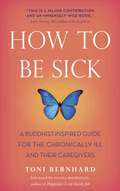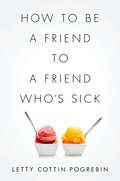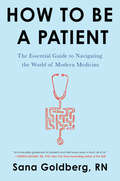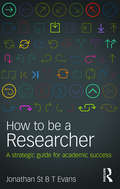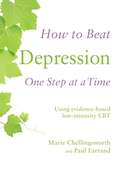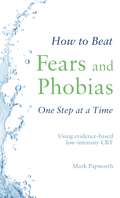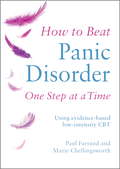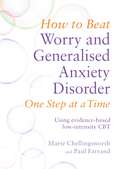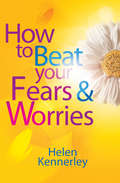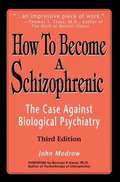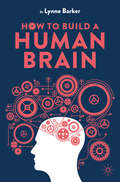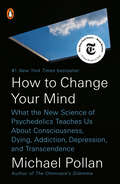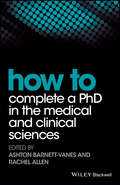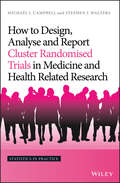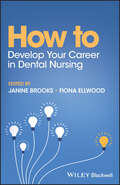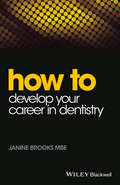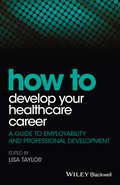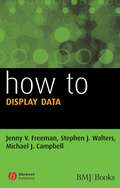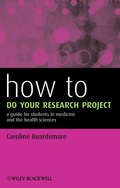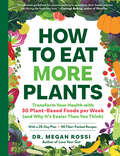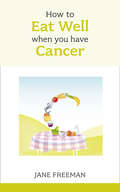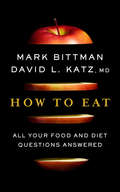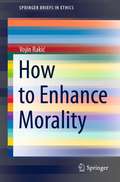- Table View
- List View
How to Be Sick
by Sylvia Boorstein Toni BernhardThis life-affirming, instructive, and thoroughly inspiring book is a must-read for anyone who is - or who might one day be - sick. It can also be the perfect gift of guidance, encouragement, and uplifting inspiration to family, friends, and loved ones struggling with the many terrifying or disheartening life changes that come so close on the heels of a diagnosis of a chronic condition or life-threatening illness. Authentic and graceful, How to be Sick reminds us of our endless inner freedom, even under high degrees of suffering and pain. The author - who became ill while a university law professor in the prime of her career - tells the reader how she got sick and, to her and her partner's bewilderment, stayed that way. Toni had been a longtime meditator, going on long meditation retreats and spending many hours rigorously practicing, but soon discovered that she simply could no longer engage in those difficult and taxing forms. She had to learn ways to make "being sick" the heart of her spiritual practice - and through truly learning how to be sick, she learned how, even with many physical and energetic limitations, to live a life of equanimity, compassion, and joy. And whether we ourselves are ill or not, we can learn these vital arts from Bernhard's generous wisdom in How to Be Sick.
How to Be a Friend to a Friend Who's Sick
by Letty Cottin PogrebinEveryone knows someone whoOCOs sick or suffering. Yet when a friend or relative is under duress many of us feel uncertain about how to cope. Throughout her recent bout with breast cancer, Letty Cottin Pogrebin became fascinated by her friendsOCO and familyOCOs diverse reactions to her and her illness: how awkwardly some of them behaved; how some misspoke or misinterpreted her needs; and how wonderful it was when people read her right. She began talking to her fellow patients and dozens of other veterans of serious illness, seeking to discover what sick people wished their friends knew about how best to comfort, help, and even simply talk to them. Now Pogrebin has distilled their collective stories and opinions into this wide-ranging compendium of pragmatic guidance and usable wisdom. Her advice is always infused with sensitivity, warmth, and humor. It is embedded in candid stories from her own and othersOCO journeys, and their sometimes imperfect interactions with well-meaning friends. "How to Be a Friend to a Friend WhoOCOs Sick" is an invaluable guidebook for anyone hoping to rise to the challenges of this most important and demanding passage of friendship.
How to Be a Patient: The Essential Guide to Navigating the World of Modern Medicine
by Sana GoldbergFrom registered nurse and public health advocate Sana Goldberg, RN, a timely, accessible, and comprehensive handbook to navigating common medical situations. From the routine to the unexpected, How to Be a Patient is your ultimate guide to better healthcare.Did you know that patients have statistically better outcomes when their surgeon is female? That you can mark-up an informed consent sheet before you sign it, or get second opinions on CTs and MRIs? That there’s a blue book for healthcare procedures, or an algorithm to decide between ER, Urgent Care, and waiting-until-Monday?In How to Be a Patient, nurse and public health advocate Sana Goldberg walks readers through the complicated and uncertain medical landscape, illuminating a path to better care.Warm and disarmingly honest, Goldberg’s advice is as expert as it is accessible. In the face of an epidemic of brusque, impersonal care she empowers readers with the information and tools to come to good decisions with their providers and sidestep the challenging realities of modern medicine.With sections like When All is Well, When It’s An Emergency, When It’s Your Person, and When You Have to Stand Up to the Industry, along with appendices to help track family history, avoid pointless medical tests, and choose when and where to undergo a procedure, How to Be a Patient is an invaluable and essential guide for a new generation of patients.
How to Be a Researcher: A strategic guide for academic success
by Jonathan St EvansHow to be a Researcher provides a strategic guide to the conduct of a successful research career within a university environment. Based on the author’s extensive personal experience, it offers down-to-earth advice, philosophical guidance, and discussions of the political context of academic research. This is not a research methods book, and the topics it covers are rarely discussed elsewhere. The bulk of the book provides practical advice on the development of essential skills and strategic approaches, covering questions such as: how to decide which topics to work on how to read and review literature how to develop theory how to integrate research and teaching activity how to approach research design how to obtain and manage research funding how to collaborate and supervise effectively how to write up your research, and how to secure the best sources of publication. The final part of the book considers the philosophy and psychology of research work and includes an exploration of the cognitive biases which may affect researchers. How to be a Researcher will be particularly useful for masters and doctoral students in the behavioral and social sciences, and also for early career academics developing research within a university career.
How to Beat Depression One Step at a Time: Using evidence-based low-intensity CBT (How To Beat #2)
by Paul Farrand Marie ChellingsworthThe IAPT programme, initiated in 2008, offers both high-intensity and low-intensity therapy. There are currently no self-help materials catering for low-intensity patients. This is the first in a new series of short self-help books for low intensity patients, covering topics such as OCD; generalised anxiety; and panic and agoraphobia. The government continues to invest in IAPT, with the focus shifting towards having more low-intensity workers. Based upon an evidence based cognitive behavioural therapy approach, this book is written in a friendly, engaging (and jargon-free!) style and encourages interactive reading through tables, illustrations and worksheets. Real life case studies illustrate the use of each intervention and demonstrate how a patient can work through an issue.
How to Beat Fears and Phobias One Step at a Time: Using evidence-based low-intensity CBT
by Mark PapworthImproving Access to Psychological Therapies (IAPT), initiated in 2008, has made psychological therapy more accessible to those in need. This series of self-help titles is the first to be created specifically for low-intensity IAPT, and all titles follow an evidence-based cognitive behavioural therapy (CBT) approach which is the treatment of choice for depression and anxiety disorders. They are written by authors with considerable experience in the field of CBT self-help research, training and clinical practice.This book is the perfect resource for helping you beat fears and phobias, either by yourself or in conjunction with the support of an IAPT service. It is written in a friendly, engaging (and jargon-free!) style and encourages interactive reading through tables, illustrations and worksheets. Real-life case studies illustrate the use of the therapy and demonstrate how you can gradually overcome your fear of the thing that frightens you. This book will help you to understand your phobia and face your fears through graded exposure therapy.
How to Beat Fears and Phobias One Step at a Time: Using evidence-based low-intensity CBT (How To Beat #10)
by Mark PapworthImproving Access to Psychological Therapies (IAPT), initiated in 2008, has made psychological therapy more accessible to those in need. This series of self-help titles is the first to be created specifically for low-intensity IAPT, and all titles follow an evidence-based cognitive behavioural therapy (CBT) approach which is the treatment of choice for depression and anxiety disorders. They are written by authors with considerable experience in the field of CBT self-help research, training and clinical practice.This book is the perfect resource for helping you beat fears and phobias, either by yourself or in conjunction with the support of an IAPT service. It is written in a friendly, engaging (and jargon-free!) style and encourages interactive reading through tables, illustrations and worksheets. Real-life case studies illustrate the use of the therapy and demonstrate how you can gradually overcome your fear of the thing that frightens you. This book will help you to understand your phobia and face your fears through graded exposure therapy.
How to Beat Panic Disorder One Step at a Time: Using evidence-based low-intensity CBT (How To Beat #3)
by Paul Farrand Marie ChellingsworthHow to Beat Panic Disorder One Step at a Time is specifically addressed to low-intensity patients and follows an evidence-based cognitive behavioural therapy (CBT) approach.This book is the perfect resource for helping you to beat panic attacks and panic disorder, either by yourself or in conjunction with the support of an IAPT service. Written in a friendly, engaging (and jargon-free!) style, the book encourages interactive reading through tables, illustrations and worksheets. Real-life case studies illustrate the use of each intervention and demonstrate how you can work through your condition. This book will help you to understand your panic cycle, and to face your fears through gradual exposure.Paul Farrand and Marie Chellingsworth have both worked at a national level in the area of CBT self-help research and training, with past involvement in organisations and programmes as diverse as the Department of Health, British Psychological Society, Psychological Wellbeing Practitioners and the British Association for Behavioural and Cognitive Psychotherapies.
How to Beat Worry and Generalised Anxiety Disorder One Step at a Time: Using evidence-based low-intensity CBT (How To Beat #5)
by Paul Farrand Marie ChellingsworthHow to Beat Worry and Generalised Anxiety Disorder One Step at a Time is specifically addressed to low-intensity patients and follows an evidence-based cognitive behavioural therapy (CBT) approach. This book is the perfect resource for helping you to beat worry or Generalised Anxiety Disorder, either by yourself or in conjunction with the support of an IAPT service. The book is written in a friendly, engaging (and jargon-free!) style and encourages interactive reading through tables, illustrations and worksheets. Real-life case studies illustrate the use of each intervention and demonstrate how you can work through your anxiety. The book teaches you effective CBT techniques for managing your worry more effectively and releasing tension through Progressive Muscle Relaxation.
How to Beat Your Fears and Worries (How To Beat #1)
by Helen KennerleyOvercoming app now available.We all worry about stuff in our lives, but some of us may find ourselves worrying excessively, even about those things completely beyond our control. Or we may simply find that worrying thoughts are dominating our daily life and are destroying our quality of life. Of course we all have worries, but rather than labelling yourself a 'worry wart' or 'worrier', you can overcome your chronic anxiety and start to lead a happier, more fulfilling life. Cognitive Behavioural Therapy, on which this self-help book is based, is a recognised, effective treatment for anxiety. It will help you to recognise and challenge your negative and anxious thoughts, and change any behaviour which may have inadvertently kept your anxiety going, and move towards a more worry-free future.
How to Become a Schizophrenic: The Case Against Biological Psychiatry
by John ModrowThe author describes his experience as a diagnosed schizophrenic and then examines the medical model of schizophrenia, which he believes to be seriously flawed.
How to Build a Human Brain
by Lynne BarkerHow to Build a Human Brain takes a developmental approach to understanding brain structure and function. It guides readers through the evolution of the human brain, from its cellular building blocks, up to hind brain structures and functions, and through to neocortex and associated functions. In doing so, it enables students to develop a comprehensive knowledge of the relationship between brain networks and functions, neural underpinnings of functional problems seen after neuropathology, and neuroanatomy.Written in an engaging style, each chapter follows a blueprint format with subsections on issues like 'damage and repair' and 'faulty wiring' as the brain is ‘built’ across the course of the book. The author includes illustrative case studies and entertaining fast fact boxes to highlight the real-word relevance of each brain structure being examined. This textbook offers an accessible reference for students of neuroscience, cognitive neuroscience, neuropsychology,and biological psychology.
How to Change Your Mind: What the New Science of Psychedelics Teaches Us About Consciousness, Dying, Addiction, Depression, and Transcendence
by Michael PollanNew York Times Book Review 10 Best Books of 2018A New York Times Notable Book The #1 New York Times bestseller.A brilliant and brave investigation into the medical and scientific revolution taking place around psychedelic drugs--and the spellbinding story of his own life-changing psychedelic experiences When Michael Pollan set out to research how LSD and psilocybin (the active ingredient in magic mushrooms) are being used to provide relief to people suffering from difficult-to-treat conditions such as depression, addiction and anxiety, he did not intend to write what is undoubtedly his most personal book. But upon discovering how these remarkable substances are improving the lives not only of the mentally ill but also of healthy people coming to grips with the challenges of everyday life, he decided to explore the landscape of the mind in the first person as well as the third. Thus began a singular adventure into various altered states of consciousness, along with a dive deep into both the latest brain science and the thriving underground community of psychedelic therapists. Pollan sifts the historical record to separate the truth about these mysterious drugs from the myths that have surrounded them since the 1960s, when a handful of psychedelic evangelists inadvertently catalyzed a powerful backlash against what was then a promising field of research.A unique and elegant blend of science, memoir, travel writing, history, and medicine, How to Change Your Mind is a triumph of participatory journalism. By turns dazzling and edifying, it is the gripping account of a journey to an exciting and unexpected new frontier in our understanding of the mind, the self, and our place in the world. The true subject of Pollan's "mental travelogue" is not just psychedelic drugs but also the eternal puzzle of human consciousness and how, in a world that offers us both suffering and joy, we can do our best to be fully present and find meaning in our lives.
How to Complete a PhD in the Medical and Clinical Sciences
by Ashton Barnett-Vanes Rachel AllenHow to Complete a PhD in the Medical and Clinical Sciences provides fresh insight into the PhD process and a concise framework to aid current and prospective students undertaking research in the medical and clinical sciences. Filled with useful hints, tips, and practical guidance, the book covers key topics relevant to a PhD researcher such as publishing and presenting, core principles and techniques in medical science, dealing with common pitfalls, and how to write up and move on. Featuring contributions from authors with experience across the PhD research career spectrum, How to Complete a PhD in the Medical and Clinical Sciences is an invaluable resource for those undertaking their doctoral studies.
How to Design, Analyse and Report Cluster Randomised Trials in Medicine and Health Related Research
by Michael J. Campbell Stephen J. WaltersA complete guide to understanding cluster randomised trials Written by two researchers with extensive experience in the field, this book presents a complete guide to the design, analysis and reporting of cluster randomised trials. It spans a wide range of applications: trials in developing countries, trials in primary care, trials in the health services. A key feature is the use of R code and code from other popular packages to plan and analyse cluster trials, using data from actual trials. The book contains clear technical descriptions of the models used, and considers in detail the ethics involved in such trials and the problems in planning them. For readers and students who do not intend to run a trial but wish to be a critical reader of the literature, there are sections on the CONSORT statement, and exercises in reading published trials.Written in a clear, accessible styleFeatures real examples taken from the authors' extensive practitioner experience of designing and analysing clinical trialsDemonstrates the use of R, Stata and SPSS for statistical analysisIncludes computer code so the reader can replicate all the analysesDiscusses neglected areas such as ethics and practical issues in running cluster randomised trialsHow to Design, Analyse and Report Cluster Randomised Trials in Medicine and Health Related Research provides an excellent reference tool and can be read with profit by statisticians, health services researchers, systematic reviewers and critical readers of cluster randomised trials.
How to Develop Your Career in Dental Nursing (How To (Dentistry))
by Janine Brooks Fiona EllwoodDocuments the challenges, benefits, and progression opportunities of a career in dental nursing How to Develop Your Career in Dental Nursing provides practical information on how to progress your career in dental nursing. Guidance is included throughout, and the reader should use the book to make informed decisions and conduct further research for the benefit of their own career. The book considers the historical context, along with reviewing the current position of dental nursing and considering the future of the field, all with the overarching theme of helping dental nurses further their career in modern dentistry. Topics covered include: Dental Nursing from a profession and social context, as well as gender perspectives Differences in dental nursing worldwide Formal and informal training and education Pros and cons for dental nurses and dentistry as the profession has developed The impact of working in a modern environment How dental nurses can become agents for change Dental nursing as an academic versus vocational endeavorWritten by highly qualified authors, How to Develop Your Career in Dental Nursing is an invaluable resource for Dental Nurses, as well as students beginning their professional journey
How to Develop Your Career in Dentistry
by Janine BrooksThis innovative new book offers a user-friendly guide to securing a successful, varied, and fulfilling career in dentistry. Includes case studies of career trajectories across the full range of dental professions in the UK Advocates a portfolio approach to career development, illustrating the benefits of working in a matrix as opposed to climbing a ladder Showcases the opportunities inherent in specific areas of dentistry, what they can offer and what is required to successfully take advantage of them Written by one of the UK's leading dental experts who has over 30 years in the profession, working on the local and national scale
How to Develop Your Healthcare Career
by Lisa E. TaylorAn informative guide to all key aspects of employability for graduating students, educators, managers, and qualified healthcare professionals. Written specifically for health professionals, focusing on their needs and the challenges they face, maximising employability potential, and managing career progression. Packed full of potential interview questions, reflection opportunities, and case studies throughout Includes chapter on Professionalism, Continuing Professional Development (CPD), and Leadership
How to Display Data (How To #26)
by Michael J. Campbell Stephen J. Walters Jenny V. FreemanEffective data presentation is an essential skill for anybody wishing to display or publish research results, but when done badly, it can convey a misleading or confusing message. This new addition to the popular “How to” series explains how to present data in journal articles, grant applications or research presentations clearly, accurately and logically, increasing the chances of successful publication.
How to Do Your Research Project
by Caroline BeardsmoreGetting involved in medical and biomedical research through necessity or personal choice can be a testing experience. Each step of the process brings its own challenges, from liaising with supervisors, to the lack of opportunities to promote completed research.This brand new How to provides a complete guide to the process: from the planning stages, to execution, write-up, preparation for the viva examination, and how to maximise the impact of your research. It ensures you get the most out of the experience, both in terms of personal development and academic achievement, and even provides guidance on what to do when things don't quite go to plan.An ideal companion, written by an experienced postgraduate tutor, this concise and user-friendly manual is full of practical exercises, key points, and hints and tips, which will give you the edge when dealing with the more elusive realities of medical and healthcare research.
How to Eat More Plants (and Why It's Easier Than You Think): Transform Your Health With 30 Plant-based Foods Per Week (and Why It's Easier Than You Think)
by Megan RossiFrom the award-winning gut health doctor and author of Love Your Gut comes a medically proven guide—featuring the revolutionary Plant Point plan—that makes it easy to fuel up on fiber and nutrients by eating 30 or more plant foods each week “A must-have guide to plant-based eating.”—Dr. Will Bulsiewicz, NYT–bestselling author of Fiber Fueled “This is the ultimate guidebook for anyone wanting to transform their health in a practical, sustainable way without sacrificing the food they love.”—Carleigh Bodrug, NYT–bestselling author of PlantYou This book was previously published in the UK titled Eat Yourself Healthy Happy gut microbes are the key to our health goals—they support our brain, skin, immunity, hormones, metabolism, and more. In How to Eat More Plants, Dr. Megan Rossi explains how to give your gut what it really craves—variety! Eat 30 different plants per week, to fuel up on fiber and nutrients Each fruit, vegetable, legume, grain, nut, and seed counts as 1 Plant Point—and getting to 30 is easier than you think. Start your journey with the 28-day Plant Points Challenge Dr. Rossi’s 4-week plan makes it fun to get more plants on the menu! Rack up Plant Points with over 80 delicious recipes Fiber-filled breakfasts: Eat-the-Rainbow Pancakes Lighter bites: Leafy Taco Wraps, Butternut Muffins Easy to-go lunches: Roasted Veggie and Freekeh Salad Protein-packed dinners: Stir-fry, five ways; Hearty Lasagna Decadent desserts: Prebiotic Rocky Road, Loaded Melon Wedges How to Eat More Plants is all about inclusion, not exclusion—whether you’re vegan, vegetarian, or just want to eat more veggies. Don’t diet—diversify. Your gut will thank you.
How to Eat Well when you have Cancer
by Jane FreemanIf you have cancer, eating well is one of the most important contributions you can make towards your own treatment. This book helps put the flavour back into food when eating may seem like a chore, with meals that will nourish and comfort you. It suggests practical ways to maintain your weight and nutrient intake while battling treatment side effects such as nausea, fatigue, lack of appetite, taste changes, and dry or sore mouth. Other topics include: surgery - preparation and recovery other methods of eating, including nutritional supplement drinks and enteral feeding food safety and avoiding infection questions about red meat, dairy products, 'superfoods' and supplements healthy eating and cancer prevention the latest research, including polyphenols.
How to Eat Well when you have Cancer
by Jane FreemanIf you have cancer, eating well is one of the most important contributions you can make towards your own treatment. This book helps put the flavour back into food when eating may seem like a chore, with meals that will nourish and comfort you. It suggests practical ways to maintain your weight and nutrient intake while battling treatment side effects such as nausea, fatigue, lack of appetite, taste changes, and dry or sore mouth. Other topics include: surgery - preparation and recovery other methods of eating, including nutritional supplement drinks and enteral feeding food safety and avoiding infection questions about red meat, dairy products, 'superfoods' and supplements healthy eating and cancer prevention the latest research, including polyphenols.
How to Eat: All Your Food and Diet Questions Answered
by Mark Bittman David KatzBestselling author Mark Bittman and physician David Katz cut through all the noise on food, health, and diet to give you the real answers you need What is the &“best&” diet? Do calories matter? And when it comes to protein, fat, and carbs, which ones are good and which are bad? Mark Bittman and health expert David Katz answer all these questions and more in a lively and easy-to-read Q&A format. Inspired by their viral hit article on Grub Street—one of New York magazine&’s most popular and most-shared articles—Bittman and Katz share their clear, no-nonsense perspective on food and diet, answering questions covering everything from basic nutrients to superfoods to fad diets. Topics include dietary patterns (Just what should humans eat?); grains (Aren&’t these just &“carbs&”? Do I need to avoid gluten?); meat and dairy (Does grass-fed matter?); alcohol (Is drinking wine actually good for me?); and more. Throughout, Bittman and Katz filter the science of diet and nutrition through a lens of common sense, delivering straightforward advice with a healthy dose of wit.
How to Enhance Morality (SpringerBriefs in Ethics)
by Vojin RakićThis book offers an innovative approach to moral enhancement. We, as humans, have a moral duty to be as good as we can be. Hence, moral bio-enhancement (MBE), if effective and safe, is our moral duty. However, it has to be voluntary because if it is made compulsory, human freedom (of the will) would be curtailed. As freedom (of the will) is an essential component of humanness, compulsory MBE would infringe upon our humanness.An essential question is; what will motivate humans to subject themselves voluntarily to MBE?The book argues - and supports by using empirical/experimental evidence - that morality and happiness operate in a circularly supportive relationship that applies to most humans most of the time: the better they are, the happier they will be; the happier they are, the better they will be. Hence, the grounding rationale for MBE ought not to be the prevention of “ultimate harm” based on compulsory MBE (as argued by Persson and Savulescu), but human happiness based on voluntary MBE. The primary objective of the book is to provide the readers with an original view on moral enhancement, whilst proposing a novel conception of moral enhancement that is informed by new biotechnological developments.
